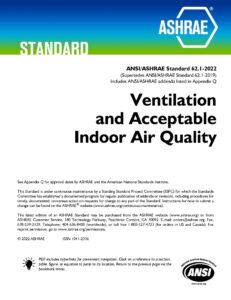Major Updates to the
Indoor Air Quality Procedure (IAQP) in ASHRAE 62.1-2022
April 6, 2022 | by Andrew Gordy
Summary
- Learn about the major changes to ASHRAE 62.1-2022 and how they impact the design of indoor environments and ventilation energy usage.
- Discover the benefits of the Indoor Air Quality Procedure (IAQP) and its potential to reduce costs and improve indoor air quality.
The American Society of Heating Refrigeration and Air Conditioning Engineers (ASHRAE) publishes the preeminent standards on many aspects of HVAC as it pertains to the built environment. Among these standards is ASHRAE 62.1, Ventilation and Acceptable Indoor Air Quality. The standard is updated on a three-year cycle; the latest iteration was the 2022 edition. Updates in ASHRAE 62.1-2022 represent one of the largest iterative changes in the standard since its inception, with major implications to the design of the indoor environment and energy used in the ventilation of buildings.
One of the largest changes in the standard is that non-transient residential units will no longer be in the scope of Standard 62.1. Non-transient residential units will henceforth be covered under the scope of Standard 62.2 Ventilation and Acceptable Indoor Air Quality in Residential Buildings. Standard 62.1-2022 has also made changes to the natural ventilation procedure; the Standard now prohibits the of natural ventilation in non-attainment zones (locations where ambient air particulate exceeds EPA limits).
Updates in ASHRAE 62.1-2022 & the A/E Industry
The most significant change in the way that the architectural and engineering fields will engage with ASHRAE Standard 62.1 concerns the Indoor Air Quality Procedure (IAQP), covered in section 6.3 of the Standard. The IAQP is one of the three primary methods of compliance with the standard, the others being the Ventilation Rate Procedure and the Natural Ventilation Procedure. The IAQP is a calculation that establishes a ventilation rate to control the build-up of common contaminants of the space analyzed. The contaminants to be controlled can come from several sources, including human effluent, off gassing of materials within the building, and even from the outdoor air introduced to the building.
While the IAQP has been a part of the ASHRAE standard for over two decades, it is infrequently implemented by engineers. The largest reason for the limited use of the IAQP to date was the ambiguity pertaining to the identification of space contaminants and the design limits thereof. The engineers who design to Standard 62.1 are frequently not experienced in environmental hygiene and are often hesitant or unqualified to establish contaminants of concern and acceptable concentration thresholds. The 2022 edition of the standard has remedied both of the major issues surrounding the application of the IAQP by both defining and establishing limits for 14 different contaminants of concern and a limit for PM2.5.
Major Benefits of the IAQP
One of the major benefits of the IAQP is that it provides a targeted ventilation rate in lieu of the prescriptive rates of the Ventilation Rate Procedure. The result is the potential reduction in the amount of ventilation air that is required to maintain acceptable indoor air quality. Along with this reduction in ventilation air required come two major benefits to a project: lower capital costs and lower operational costs. With smaller volumes of outside air required to be conditioned, there are lower requirements for equipment capacity; smaller equipment capacities mean smaller HVAC equipment and potentially smaller electrical feeders, resulting in lower capital costs. The reduced ongoing need to condition outside air results in lower operating costs; conditioning outside air for ventilation is expensive!
There are devices on the market that are designed to control the build-up of air contaminants within building spaces by adsorbing (adhering to special filtration media) the contaminants of concern. The devices are intended to further decrease the potential need for ventilation air required by the IAQP method and increase the cost benefits to a project. Some manufacturers claim to be able to reduce outside air requirements by up to 80% and reduce HVAC energy costs of a system by up to 40%. The adsorbent devices are also great options for retrofits into existing buildings that may not have adequate architectural space to deliver adequate ventilation air to meet requirements.
IAQP & LEED Certification
Finally, the updates in ASHRAE 62.1-2022 have several potential positive implications to projects seeking LEED certification. The U.S. Green Building Council (USGBC) has pathways for the IAQP to satisfy the requirements of the Minimum Indoor Air Quality Performance ventilation prerequisites on projects. Additionally, the energy savings on ventilation when compared to an ASHRAE baseline can result in large LEED point gains in the Optimize Energy Performance credit. Also, the USGBC has previously had pilot credits that allow projects implementing the IAQP to gain points in several other categories related to indoor air quality. That pilot credit has since closed, but the USGBC is exploring future pilot credits to incorporate the IAQP into LEED programs.
The updates adopted by ASHRAE 62.1-2022 open the door to more widespread adoption of the IAQP method. The method allows for buildings to be ventilated with a smaller volume of outside air while still maintaining acceptable indoor air quality. Reducing the amount of ventilation air in a given mechanical system has large implications in project costs: less outside air to condition means lower operating costs and lower capital costs associated with smaller peak equipment capacities. The Indoor Air Quality Procedure (IAQP) can be an excellent opportunity for LEED projects to save energy, save money, and improve indoor air quality.
For additional information on the updates in ASHRAE 62.1-2022, resources, or more about how the Indoor Air Quality Procedure (IAQP) can benefit your LEED project, contact Andrew Gordy, PE at andrew.gordy@loraxllc.com.

